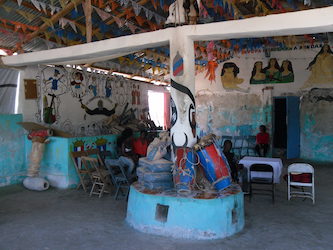
Potomitan (also spelled poteau-mitan, poto mitan, poto-mitan). Translation: “central pole” in Haitian Creole. An essential structural feature of the hounfour (temple) in Haitian vodou. Occupying the central position in the peristyle (sacred space at the center of the hounfour / oufo), the potomitan takes the form of a decorated wooden post (occasionally a living tree) by means of which, it is believed, the loa descend to Earth to inhabit, for a time, the bodies of the faithful through spirit possession.
The structure consists usually of the whole trunk of a palm tree, being fixed to the ground by a masonry pedestal. A potomitan is often painted with designs in bright colors, usually featuring the motif of two intertwined serpents, symbolizing the primordial male and female divine couple Damballa and Ayida Weddo who, according to the cosmogony of the Haitian religion, support the sky, preventing it from crumbling and falling to Earth.
Taken its entirety, however, the ritual post represents the deity Papa Legba, the gatekeeper or messenger of the BI, without whose intercession communication with the realm of the divine would be impossible.
Sacrifices are carried out regularly to sanctify the structure and honor the deity, either at the foot of the potomitan itself or at the base – most notably prior to Vodou ceremonies proper – to keep it a fit conduit for the transmission of the divine powers. The potomitan constitutes a ritual representation, in a specifically Haitian context, of the axis mundi and, more specifically the world tree.